Phoenix Area Office - Programs & Activities
Environmental Resource Management
Protecting the Natural Environment
RECLAMATION AND THE FOSSIL CREEK FISH BARRIER
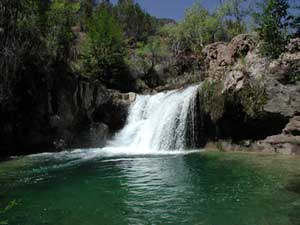
Fossil Creek
The Mazatzal Wilderness encompasses over 252,500 acres within two national forests. Designated as a wilderness area in 1940,
its name means "Land of the Deer." This beautiful area is a vast expanse of rolling hills, mountains, and canyons.
On a northern edge of the wilderness, about halfway between Phoenix and Flagstaff , Fossil Creek lies on a portion of the
border between Yavapai and Gila Counties and serves as part of the border between the Coconino and Tonto National Forests .
The creek now embodies one more border - the one between a flourishing and diverse native fish habitat and one where natives
have been crowded out by transplanted sport fishes and other non-natives from outside the Gila River basin .
John McGlothlen , Reclamation's Phoenix Area Office Environmental Biologist, explains that perennial streams
throughout Arizona are threatened by predatory, nonnative fish species. "Fossil Creek offered a rare opportunity to restore
a purely native assemblage of fishes, and serve as refugia for repatriation of threatened and endangered fishes that are endemic
to the Gila River basin ."
Engineers in the Phoenix Area Office designed a fish barrier that could protect the middle and upper reaches of Fossil Creek and
return it to the purely native and natural state that McGlothlen envisioned.
The Phoenix Area Office's Environmental Resource Management Division was excited about the Fossil Creek restoration.
The creek seemed to evoke admiration. "Fossil Creek is emblematic of streams that once flourished in Arizona .
Despite being starved of water by diversions to APS' Childs-Irving hydroelectric facilities, Fossil Creek persisted
as one of the few and vanishing streams that still contain a diverse community of native fishes," explains McGlothlen.
How can precious native fish populations be protected? A 1994 Fish and Wildlife Service biological opinion identified
artificial fish barriers as one method. The Phoenix Area Office has already completed two such barriers on Aravaipa Creek
and has plans for several more around the state where repatriation has been identified as the desired management activity.
Erecting a fish barrier involves building a concrete structure across the creek; removing the currently identified native
fishes from the stream; treating the stream with a piscicide (think pesticide for fish) to remove the nonnative species; and,
finally, reintroducing the native fish into the creek.
In the case of Fossil Creek, the six species of native fish currently in the creek were preserved. In addition, those species
that historically inhabited the stream but no longer can be found there will be repatriated. Native fishes expected to be
repatriated include Verde River spikedace, loach minnow, Gila topminnow, desert pupfish, razorback sucker, Colorado pikeminnow,
woundfin, and flannelmouth sucker.
Since June 2002, in preparation for this project, Reclamation has been monitoring segments of the creek to determine the
presence of algae, invertebrates, fish, amphibians, and reptiles. Intensive monitoring will be done after the fish barrier
construction is completed to guard against new incursions of nonnative fishes and check on how the natives are doing.
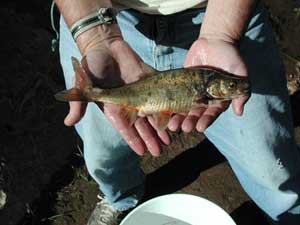
A roundtail chub - one of six species of native fish
currently surviving in Fossil Creek
The wilderness designation presented just one of the unique challenges this project faced. The designation required special justification explaining why the proposed location was preferable to building outside of the wilderness area. Rob Clarkson , Phoenix Area Office Fishery Biologist, explains the justification succinctly. "The wilderness site protected a longer length of stream, and it moved the barrier away from most public access, reducing the potential of the public to move nonnative fishes above it."
In his Decision Notice, the Regional Forester for the Southwest Region of National Forests concurred that the value of restoring the natural ecological function of the stream justified the time and space intrusions into the wilderness area. From the Decision:
" Arizona ranks as the number one state in the United States for the percentage of native fish species at risk (Stein 2002). Since there are very few opportunities for restoration, the additional 2.8 miles of native fish habitat within the Mazatzal Wilderness provided by the wilderness barrier alternative is disproportionately important ."
Another issue was the use of "non-conforming" construction methods within the wilderness, such as a helicopter, mechanical construction devices, and a generator. "We argued that if the purpose and need for the project was valid, we could actually reduce long-term impacts to wilderness values by compressing the length of time we would be in the wilderness doing the construction by using modern construction methods," Clarkson says.
And compressing the construction time was crucial to this project. Once the Forest Service issued a permit allowing Reclamation to begin construction, the window of opportunity for construction activity was constrained to the period from the end of September (when the monsoon rains are over) to the end of October. This left the months of November and December for applying the piscicide and reintroducing the native fish into the creek before the de-commissioning of the Childs-Irving Hydroelectric Project increased the base flows within Fossil Creek from the current 5 percent to its full flow.
THE CHILDS-IRVING HYDROELECTRIC PROJECT
In the early 1900's, Arizona Power Company built the Childs and Irving hydroelectric facilities. As a result, the Fossil Springs diversion dam and a series of flumes, tunnels, and pipes diverted almost all of the Fossil Creek base flow to two turbines that generated 4.2 megawatts of electricity.
This electricity once powered Jerome's mining industry and, in the mid-1920's, provided power to SRP during a drought that emptied SRP's reservoirs. In the 1920's, when Arizona 's total population was a lazy, hazy 330,000 non-air-conditioned residents, 4.2 megawatts was a lot of power generation.
But that's only enough electricity to power 850 homes in modern times. In the 21st century, and with almost 1.5 million people in Phoenix alone, that was not enough justification to extinguish the sparks flying from environmental groups. APS wisely decided to abandon the project and return the water to Fossil Creek.
Among the things the contractors were up against were using a helicopter to lower equipment, material, and supplies into the remote area and transport collected native species to holding tanks; construction crews had to hike into the project area (after receiving "leave no trace" training); rehabilitating the trail used to hike in following completion of construction; and texturing and coloring the fish barrier to blend with the surrounding environment. Six contract workers were stationed and camped in Fossil Creek to complete the construction, with Reclamation oversight.
 Worker's Camp Site |
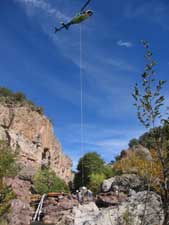 Concrete is delivered to the worksite via helicoptor |
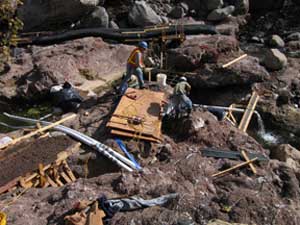 Worker's At Construction Site |
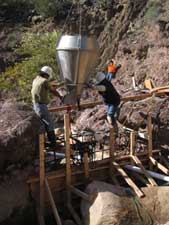 Worker's Pour Concrete |
On June 18, a ceremony marked the completion of the Fossil Creek project when water was returned to the full flow of 43 cubic feet per second, restoring 14 miles of riparian ecosystem.
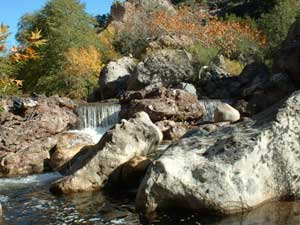
Completed Fossil Creek fish barrier, constructed by
Bureau of Reclamation, Phoenix Area Office
WHY DOES RECLAMATION BUILD FISH BARRIERS ?
In a 1995 Fish and Wildlife Biological Opinion on the effects of the Central Arizona Project, which stated its long-term operation would jeopardize the continued existence of several federally-listed species of native Arizona fishes, fish barriers were identified as a reasonable and prudent alternative. In 2001, construction of a fish barrier in Fossil Creek was included as a required measure.
An Environmental Assessment (EA) for the Fossil Creek proposed project addressed comments from the public and was approved by the U.S. Forest Service on June 8, 2004, the same day that Phoenix Area Manager Carol Lynn Erwin signed a "Finding of No Significant Impact" on behalf of the Bureau of Reclamation.
When the publicly announced appeal period for the Final Environmental Assessment on the impacts of constructing a fish barrier on Fossil Creek expired with no appeals filed, the last hurdle in a long process had passed. At that time, the Forest Service issued a special use permit to Reclamation to construct the barrier.
Cooperating agencies involved in restoring Fossil Creek (above the barrier) to a purely native fish assemblage are the Bureau of Reclamation; the U.S. Department of Agriculture's Forest Service (involving two National Forests: Coconino and Tonto); Fish and Wildlife Service; and the Arizona Game and Fish Department.

